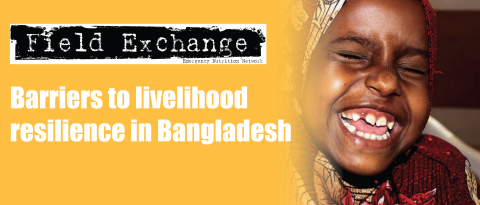Something for everyone: three perspectives from a recent coverage assessment in Pakistan
Summary of review1

Lady Health Worker and her husband (teacher) working as volunteers
Interview by Saul Guerrero, ACF
Action Against Hunger, in collaboration with the Coverage Monitoring Network (CMN) Project, UNICEF Pakistan and the Nutrition Cluster and its partners, recently carried out a coverage assessment in one of its supported CMAM programmes in Sindh Province, Pakistan. The assessment, supported by Mark Myatt (independent consultant), served to provide on-the-job training on the SQUEAC method to a mixed group of non-governmental organisation (NGO) and UN staff. But what was the experience of doing a coverage assessment like for ACF staff at programme, country and HQ level? We asked them how their view of the programme has changed since the assessment and which parts of the process they would like to see integrated into their way of working.
| How has the SQUEAC changed the way you now look at the programme? | Which part of the process are you most interested in seeing continue routinely? | |
Shahid Fazal, ACF Nutrition Coordinator, Pakistan |
This new methodology has changed our way of thinking and has proven that evaluation of nutrition programmes can be done on a routine basis along with timely reforms. We get a clear insight into the barriers and can recognise the actual contribution of specific ‘boosters’1. It is like turning the stone upside down and going deeper into programme planning and implementation modalities. | The tally sheets give a wonderful glance at the trends of quality indicators such as mid-upper arm circumference (MUAC) on admission, travel times, admissions and exits over time. Incorporating some of these indicators (along with the more common Length Of Stay and Average Weight Gain) will give us a qualitative image of the programme on a weekly/monthly basis. |
Chris Golden, ACF Deputy Country Director, Pakistan |
The SQUEAC methodology, and Mark [Myatt] as a presenter, makes a persuasive case to reconsider our existing assessments and gives a new appraisal of what they teach us, but also what they don’t reveal due to their structure and often limited focus. I would say this process has definitely opened the eyes of many of the people who participated in it. | The process provided the teams not only with training on the methodology of SQUEAC but also with good advice on implementing thorough assessments that will produce robust results. |
Cecile Basquin, ACF Nutrition Advisor, USA |
Prior to the SQUEAC investigation in T.M. Khan district, it was difficult to evaluate how efficient our community mobilisation approach was. Now we know that the work of Community Volunteers is acting as an important booster to access. This SQUEAC exercise allowed us to identify what works and therefore gave us confidence we can replicate the approach. Very impor- tantly, we also learned about pro- gramme areas that need to be stren- gthened or improved, and resulted in programmatic recommendations and concrete actions points. | The SQUEAC analysis has led the team to have a more critical view on their work and now they have a different way of looking at routine CMAM data. The reflection that was done while building the hypothesis about coverage (Stage 1) is definitely something that should be done on a more regular basis and with all team members. Doing this ‘brainstorming’ continuously with the key determinants of coverage in mind and having this critical way of thinking regularly, is likely to contribute to increased quality and coverage, so we can only encourage it. |
1See field article in this issue ‘Boosters, Barriers, Questions: an approach to organising and analysing SQUEAC data’.
Imported from FEX website





